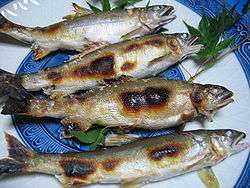Definify.com
Definition 2025
鮎
鮎
Translingual
Han character
鮎 (radical 195 魚+5, 16 strokes, cangjie input 弓火卜口 (NFYR), composition ⿰魚占)
- A sheatfish, the Japanese catfish, Parasilurus asotus.
References
- KangXi: page 1468, character 10
- Dai Kanwa Jiten: character 46070
- Dae Jaweon: page 2001, character 16
- Hanyu Da Zidian: volume 7, page 4680, character 14
- Unihan data for U+9B8E
See also
Japanese
Kanji
(“Jinmeiyō” kanji used for names)
Readings
Etymology 1
| Kanji in this term |
|---|
| 鮎 |
|
あゆ Jinmeiyō |
| kun'yomi |
Uncertain.
- One commonly encountered etymology suggests that ayu may derive from 饗 (ae, “hosting someone to a meal”), in reference to the way that this fish may be used in Shinto offerings.[1] However, this would have been pronounced ape in ancient times, and while this ape did later become ahe, and a shift from -he to -ye did occur in many terms during the Muromachi period[2], the word ayu in reference to the fish appeared in the Man'yōshū dating to the late 700s at the latest, and is thus too old for this shift to have occurred.
- Another common etymology states that ayu may be from extinct Old Japanese term 落ゆ (ayu, “to fall, as nuts from a tree; to flow down, as liquid in a stream”), in reference to the way that ayu swim downstream to spawn in the autumn.[1] Some references[3] suggest that this is not very eventful and that this etymology is therefore unlikely. However, there are terms specific to the ayu downstream migration, such as 落鮎 (ochiayu, “ayu migrating downstream to spawn”) and 鮎落つ (ayuotsu, “ayu migrating downstream to spawn”), suggesting that this event has been culturally important enough that the 落ゆ (ayu) derivation may be plausible.
- Alternatively, this term may be borrowed from Ainu アイ (ay, “arrow”) in reference to how fast the fish moves. See also obsolete Japanese reading ai below.
The kanji spelling 鮎 in reference to sweetfish is specific to Japan, probably in reference to the way the fish (魚) stakes out its territory (占). There is another tale wherein Empress Jingū caught an ayu and thereby prophesied (also spelled 占) the outcome of a battle, but this is likely a folk etymology. In China and elsewhere, the 鮎 character refers instead to catfish.[2]
The kanji spelling 年魚 is in reference to the common one-year lifespan of this fish.[2][4]
The kanji spelling 香魚 is in reference to its sweet-tasting flesh.[4]
Pronunciation
Alternative forms
- 年魚, 香魚
Noun
鮎 (hiragana あゆ, katakana アユ, romaji ayu)
- A sweetfish, an amphidromous fish of East Asia, the only member of its genus, Plecoglossus altivelis, prized for its sweet-tasting flesh. It is a game fish and is also subject to extensive aquaculture.
Usage notes
As with many terms used in biology, this term is often spelled in katakana.
Derived terms
|
|
Etymology 2
| Kanji in this term |
|---|
| 鮎 |
|
あい Jinmeiyō |
| kun'yomi |
Obsolete variant of ayu pronunciation. May have been the original pronunciation.
Pronunciation
Noun
- (obsolete) see ayu above
Usage notes
Found in some compounds. Generally not used on its own.
Derived terms
Etymology 3
| Kanji in this term |
|---|
| 鮎 |
|
なまず Jinmeiyō |
| kun'yomi |
The kanji spelling 鮎 in reference to sweetfish is specific to Japan. In China and elsewhere, the 鮎 character refers instead to catfish.[2] See the 鯰 entry for more detail about the Japanese term namazu.
Pronunciation
Alternative forms
- 鯰 (more common)
Noun
鮎 (hiragana なまず, romaji namazu, historical hiragana なまづ)
- (rare) a catfish
References
- 1 2 1988: あて字のおもしろ雑学 (Interesting Ateji Trivia, in Japanese), Freelance Trivia Writers, p.46, Nagaokashoten, Ltd.
- 1 2 3 4 1988, 国語大辞典(新装版) (Kokugo Dai Jiten, Revised Edition) (in Japanese), Tōkyō: Shogakukan
- ↑ Gogen Allguide, http://gogen-allguide.com/a/ayu_sakana.html
- 1 2 3 4 2006, 大辞林 (Daijirin), Third Edition (in Japanese), Tōkyō: Sanseidō, ISBN 4-385-13905-9
- 1 2 1998, NHK日本語発音アクセント辞典 (NHK Japanese Pronunciation Accent Dictionary) (in Japanese), Tōkyō: NHK, ISBN 978-4-14-011112-3
Korean
Hanja
鮎 • (jeom) (hangeul 점, revised jeom, McCune-Reischauer chŏm, Yale cem)
Synonyms
- 鰋 (언, eon)
Mandarin
Hanzi
鮎 (simplified 鲇, Pinyin nián (nian2), Wade-Giles nien2)
- This term needs a translation to English. Please help out and add a translation, then remove the text
{{rfdef}}.
Vietnamese
Han character
鮎 (chẻm, niềm, nhương)
- This term needs a translation to English. Please help out and add a translation, then remove the text
{{rfdef}}.
